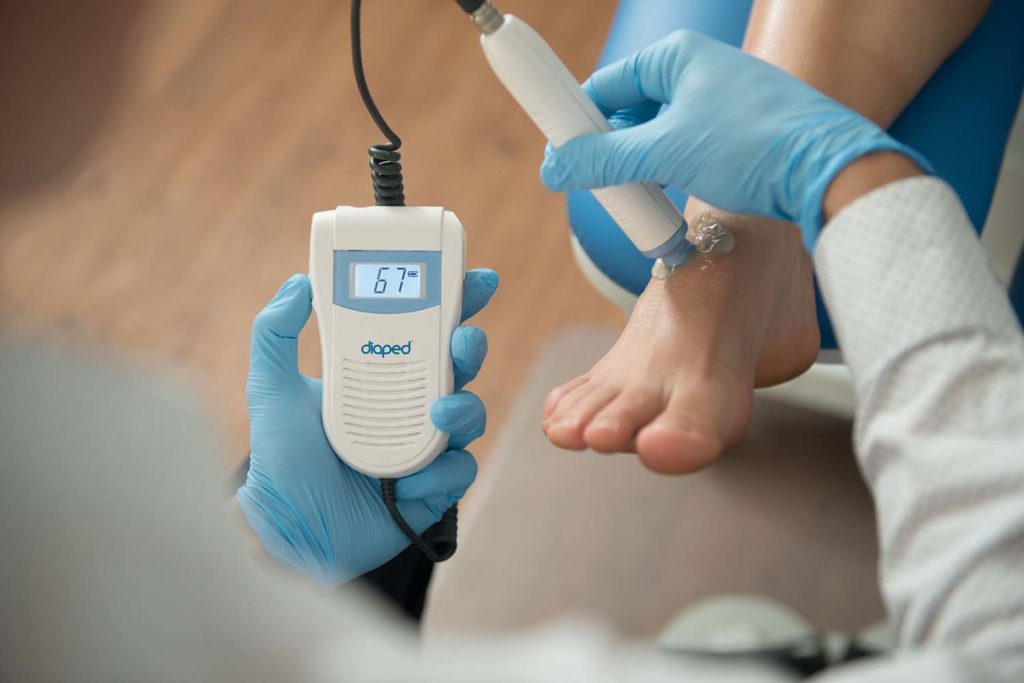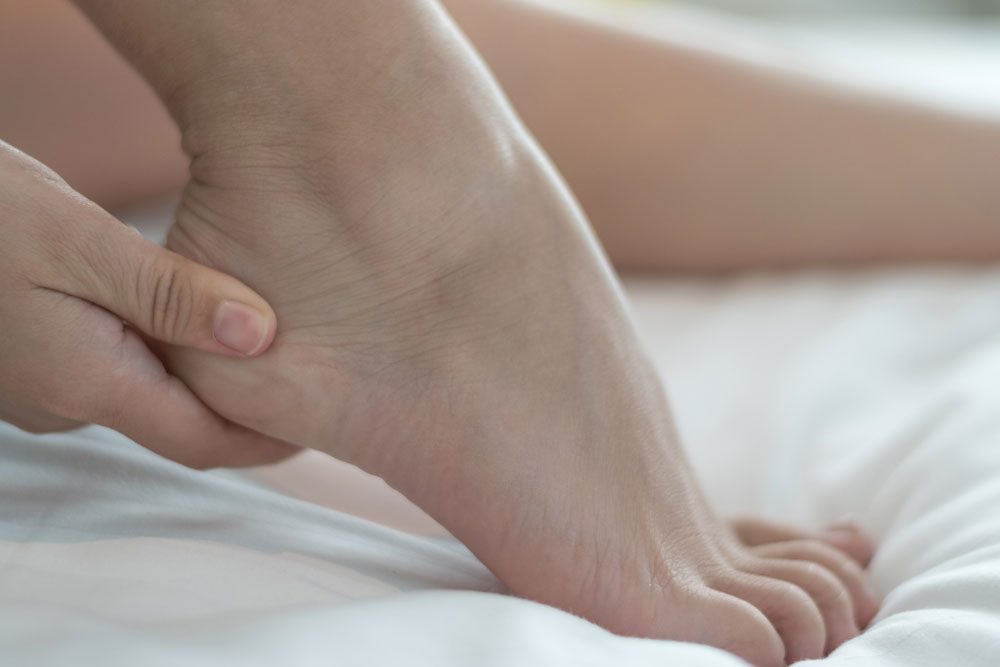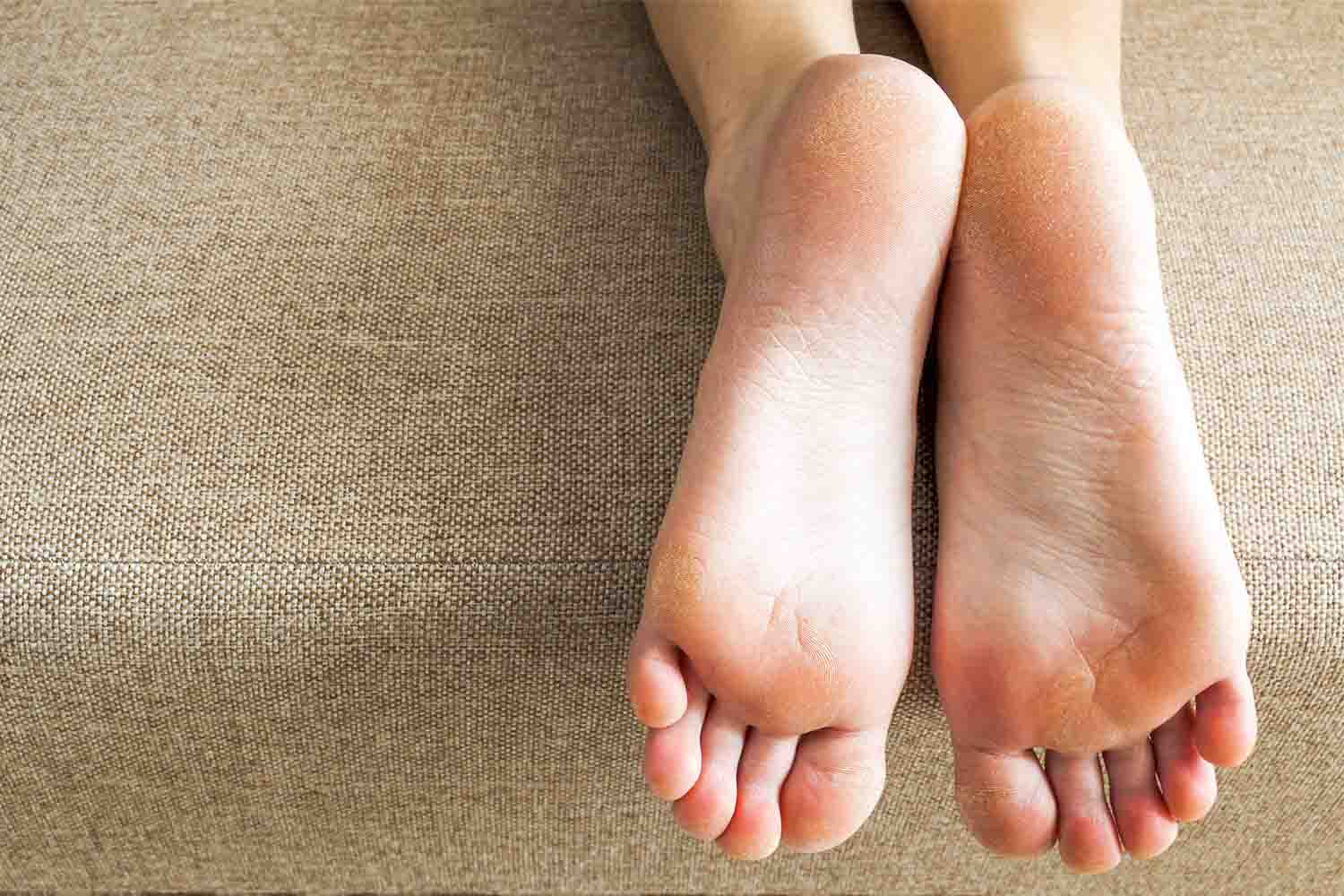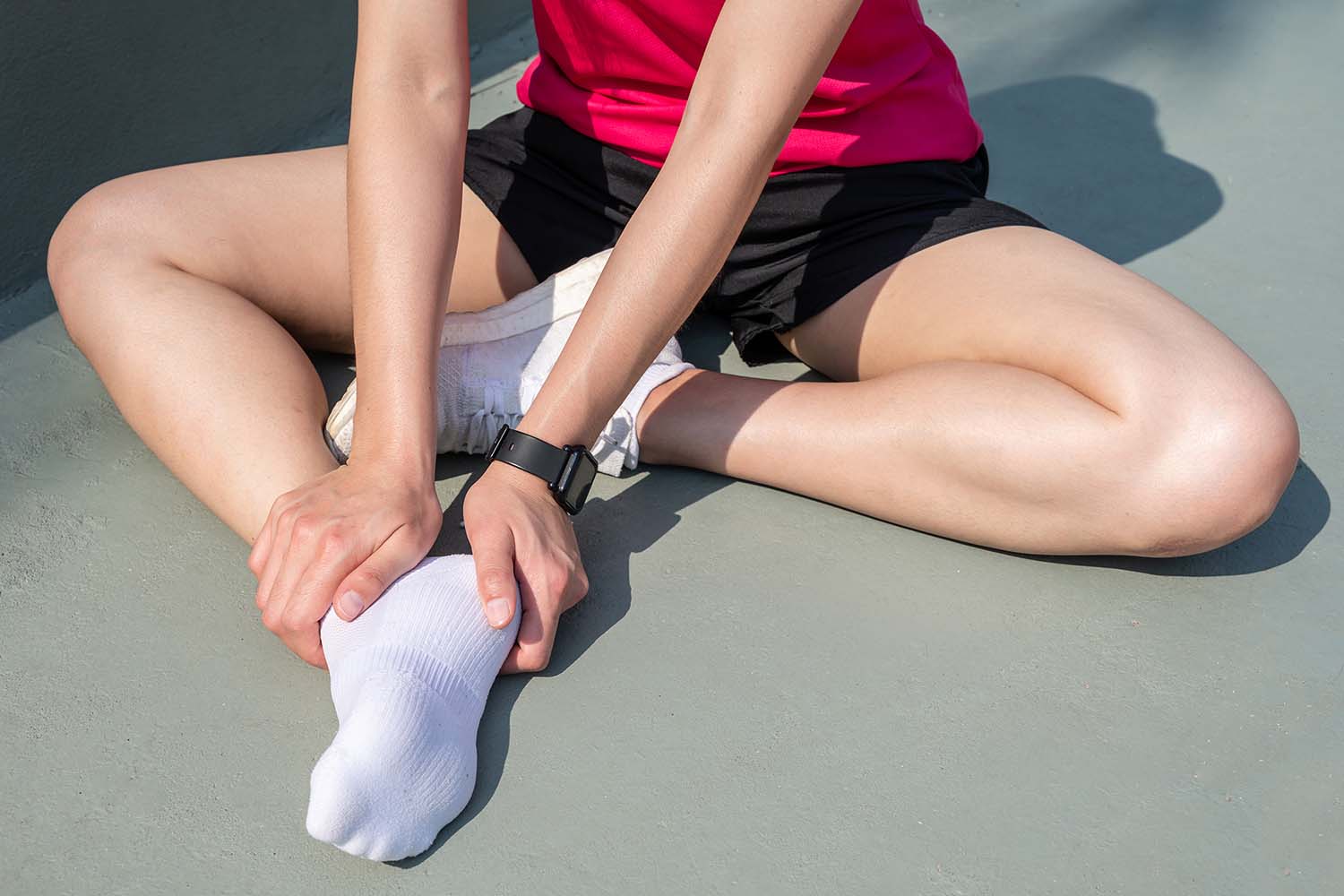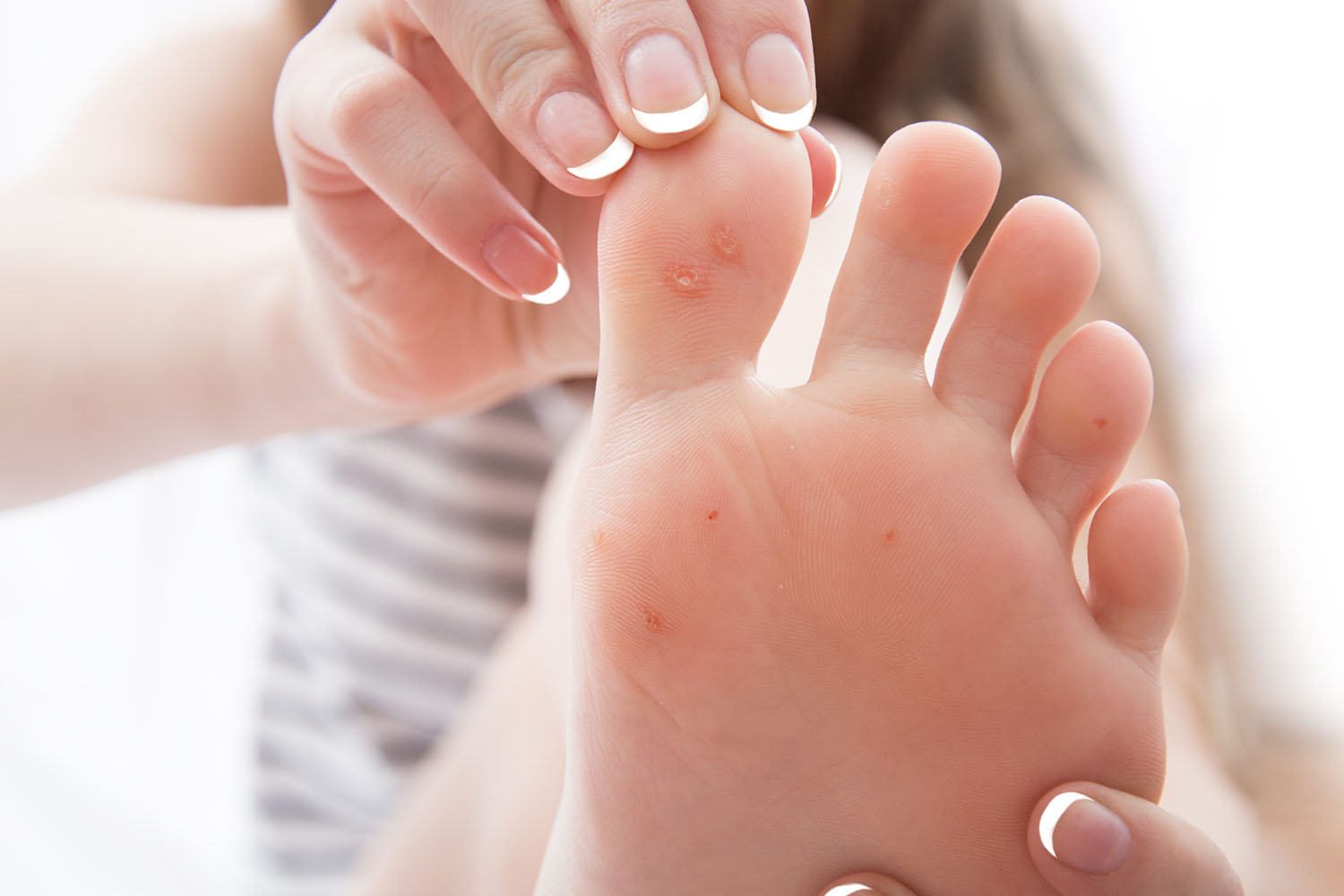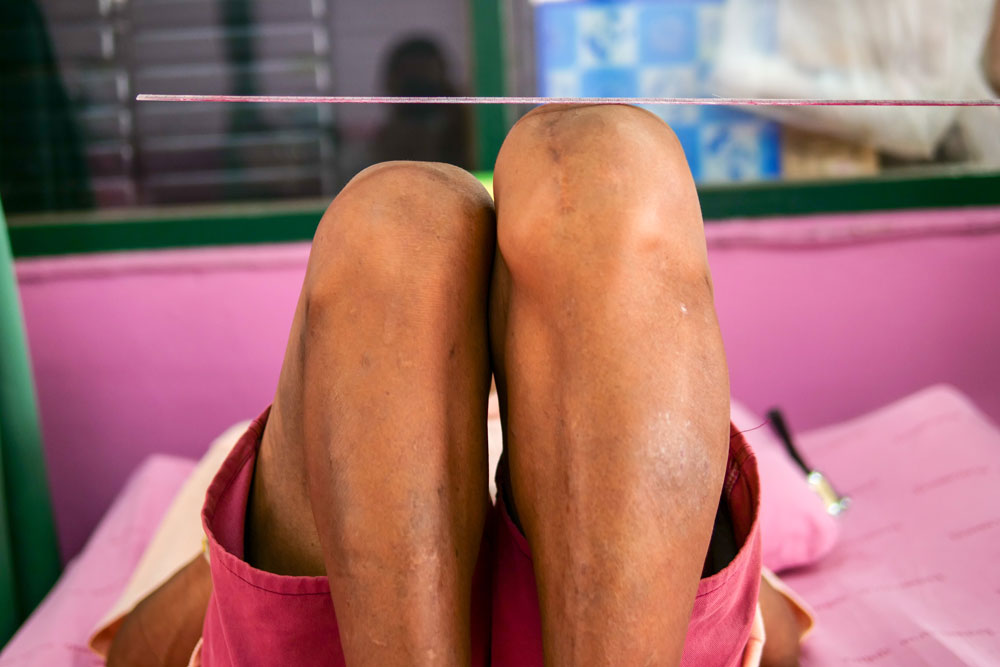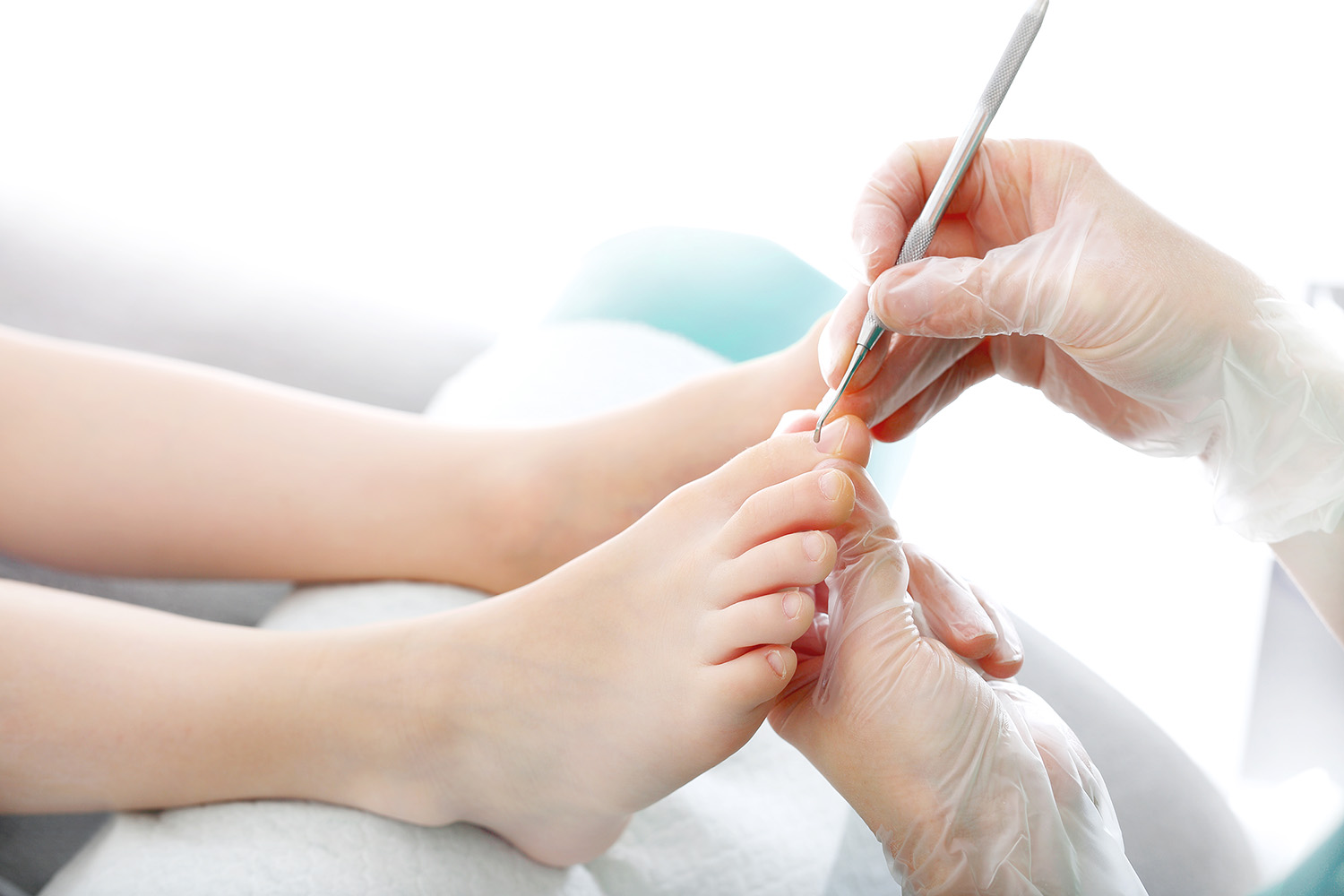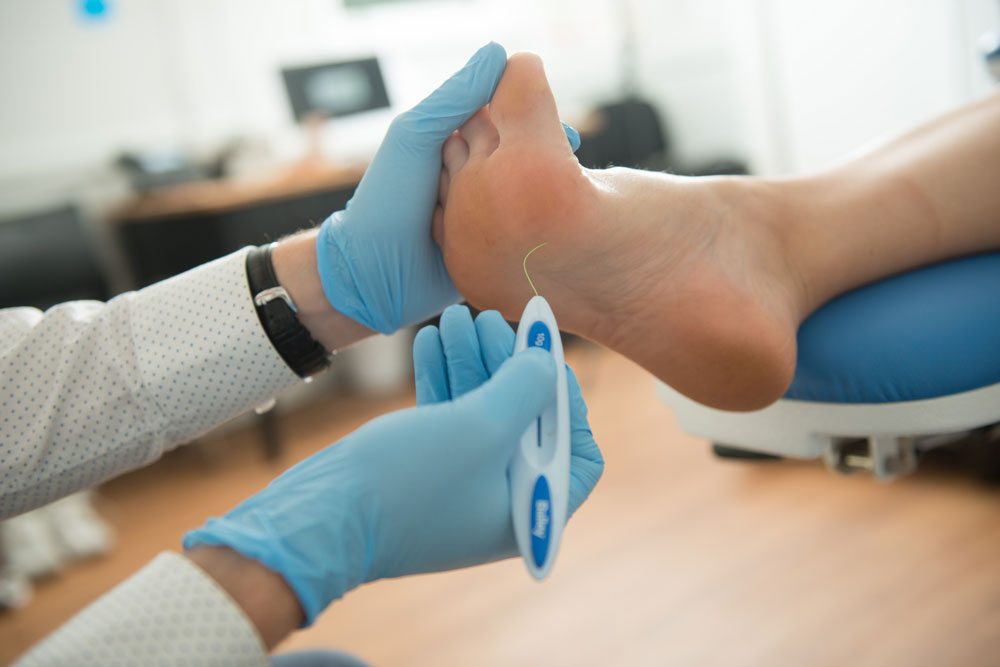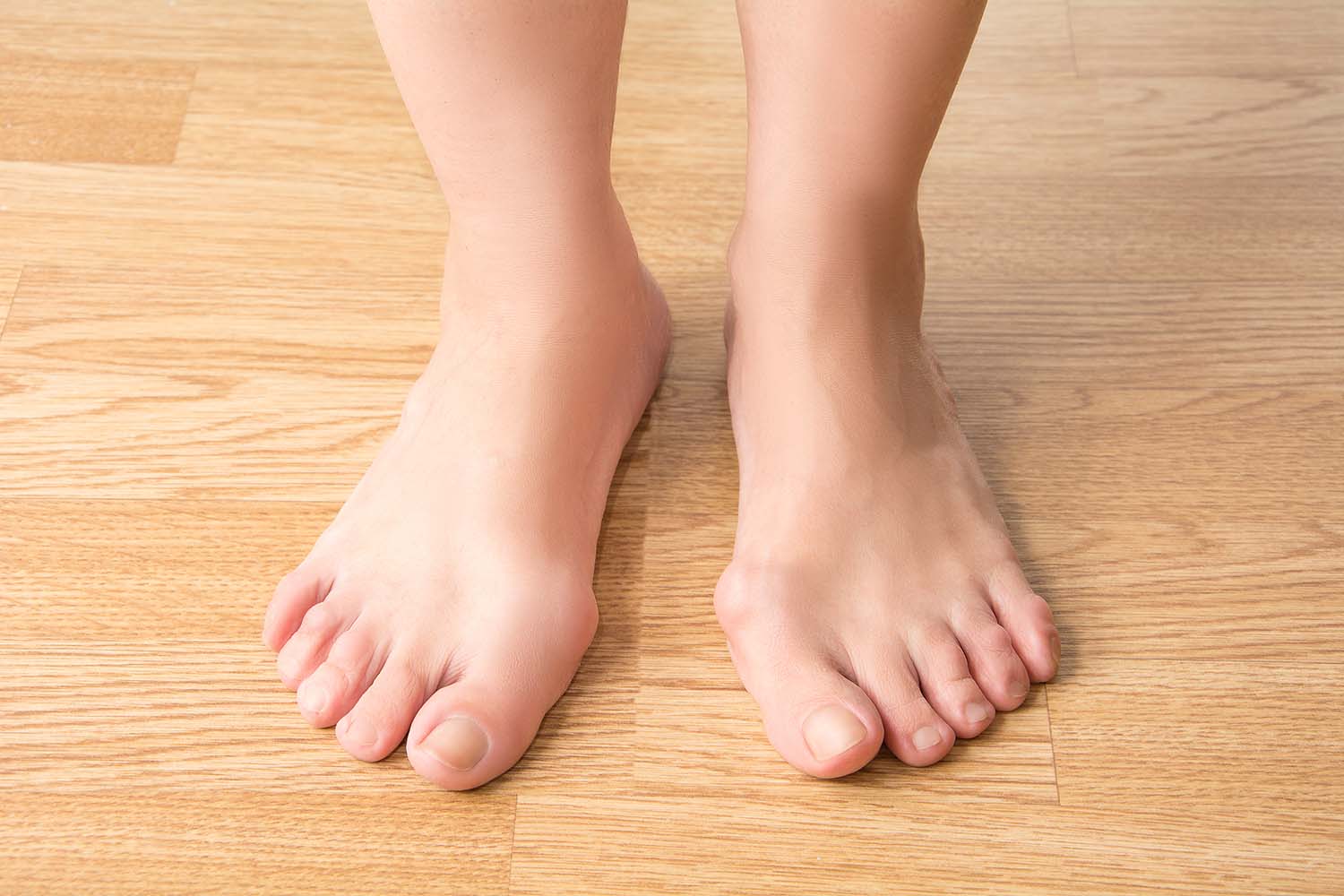Plantar Warts – Verruca Pedis
Warts on the feet can be painful and spread over time. Thankfully they’re not as serious as other foot conditions because they only impact you at the skin level. That said, people often choose to remove these annoying and unpleasant warts to improve the appearance of their feet and to stop any pain when walking and wearing shoes.
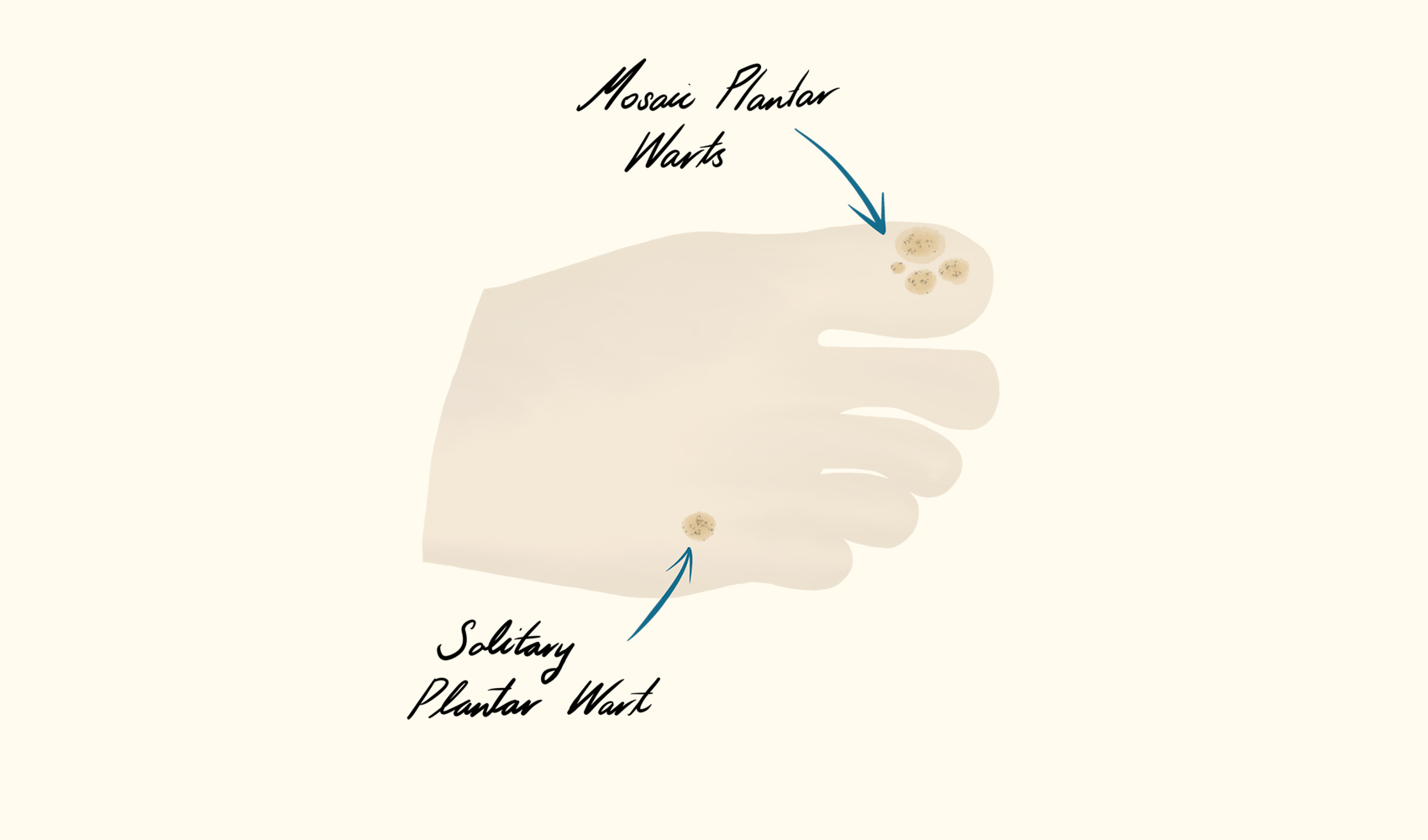
What are Plantar Warts?
The word ‘plantar’ defines the area relating to the sole of the foot, therefore plantar warts occur on the underside of people’s feet. Also known as verruca pedis, plantar warts look like a grainy, rough and fleshy growth (lesion) with black pinpoints. These black dots are commonly thought to be wart seeds or roots but are actually small blood vessels. Usually round, they often appear on the bottom of toes, heels or the balls of the feet where weight bearing occurs. This pressure may commonly cause plantar warts to grow inwards and appear flat instead of raised.
Types of Plantar Warts
- Solitary Plantar Warts
A solitary plantar wart is as the name suggests: a single wart on its own. - Mosaic Plantar Warts
Mosaic plantar warts grow in clusters closely together and are more difficult to treat.
The Difference between Plantar Warts, Calluses and Corns
Plantar warts are often confused with calluses or corns and can therefore be left untreated. Due to this, it is very important that a podiatrist examines the foot to give a correct diagnosis and thus an accurate treatment plan.
Calluses
Calluses are built up areas of thick dead skin. These are most likely seen on the bottom of feet, specifically bony areas which carry a large portion of a person’s body weight. Calluses are often larger and have a more spread-out irregular shape.
Corns
On the other hand, corns tend to be small and round with a hard centre surrounded by inflamed skin. Corns commonly develop on parts of the foot that do not bear weight, such as the side and tops of toes. They can often appear where there is unnatural repeated friction or rubbing due to ill fitted footwear.
In essence, the main differences between warts, calluses and corns are:
Calluses/ Corns
- No black dots providing blood supply
- Can be painful when pushed on directly
- Skin lines continue, even though skin is dead, raised or hard
Warts
- Small black blood supply dots
- Painful when squeezed side to side
- Interrupts the skin lines
A distinguishing characteristic is that plantar warts will often bleed whereas in most cases corns and calluses will not. It’s important to note that sometimes mosaic warts will have thicker skin on top, with many people confusing them for a callus. This reiterates the importance of having a trusted podiatrist provide a proper diagnosis.
Where do Warts Come From?
We know that warts are non-cancerous (benign) skin growths, but often people have little understanding of where they actually come from. So, if you’ve ever wondered, ‘Why do I have warts?’ then read on.
A wart is caused by certain types of human papillomavirus (HPV). There are more than 100 types of HPV, causing a wide variety of conditions. The majority are actually quite harmless and common, producing no symptoms whatsoever and will often go away on their own without any treatment.
Many people are already aware of the more serious HPV types which can cause head, neck, throat, vaginal, cervical, penile and anal cancer. Somewhat less known is that there are some HPV types which cause common warts (over the entire body), plantar warts (on the feet) and genital warts.
Podiatrists deal with the different types of verruca (warts) that pertain to the lower limb. Most often they are located around either the foot or ankle. Types of HPV addressed by podiatrists are:
- Single, deep plantar warts
- Mosaic warts (range in size but are found in clusters)
- Raised warts
- Common: found on the backs of knees and toes
- Periungual: found at the side or underneath the toenail, sometimes leading to abnormal nail growth
This virus thrives in warm, moist environments and can often be found in community spaces like swimming pools, locker rooms, dorms and public showers. It can also reside in pumice stones, on nail clippers, towels, razors and other items which may have come into contact with an existing wart. If the virus is present in the surrounding environment, it can enter the body through moist, soft skin or tiny cuts or breaks on the bottom of a person’s feet.
Plantar Warts and the Immune System
In most cases, warts are relatively harmless for people with a healthy and robust immune system. A person’s immune system will often fight the virus and the warts will subsequently disappear in their own time. How long this will take is dependent on:
- The specific type of HPV
- How the wart presents
- The person’s general overall health
Human papillomavirus causes the cells of the epidermis (the outermost layer of skin) to reproduce rapidly, therefore creating a wart. The body’s immune response is what works to eliminate the warts. It attacks and destroys the virus infection.
Unfortunately, the immune system mainly operates from the dermis, this is the layer of skin directly beneath the epidermis (our visible skin). As a result, it can take some time before the immune system registers the infection and subsequently mounts a response that will shed the wart virus and therefore the wart.
Who’s most at risk of getting plantar warts?
Interestingly, each person’s immune system will have a different response to human papillomavirus. Not all those people who come into contact with the human papillomavirus will develop warts. It is even quite common for members of the same family within the same home to react to the virus differently.
It’s understandable then that people more likely to develop or present with plantar warts are:
- Immune suppressed
- Those often barefoot
- Children
- People who swim, play team sport and use change room facilities regularly
- Individuals who have multiple skin grazes or cuts
Wart Symptoms
Plantar warts can be asymptomatic or symptomatic depending on each person’s unique case.
Asymptomatic Plantar Warts
Plantar warts can be asymptomatic. This means that although present, the wart/s are not painful or disruptive to everyday activities. Most often it is the size and unsightly appearance of the warts that instigate people to seek out treatment by a qualified health professional like a podiatrist. This said, it is wise to address asymptomatic plantar warts because they can become more problematic with time and take longer to treat.
Symptomatic Plantar Warts
In many instances plantar warts cause multiple debilitating symptoms like pain and tenderness when walking and standing. This occurs when the verruca (plantar wart) forms in a weight bearing section of the foot, causing extreme discomfort as pressure is applied to the wart/s with every step. It can be severe enough that a person will compensate their natural gait / walking style to avoid the pain and therefore cause serious secondary problems as a result.
Preventing Existing Plantar Warts Spreading
It’s a well-known saying that ‘prevention is better than a cure’. The chances are though, that if you’re reading this article then you or a loved one already has plantar warts. So, the following preventative recommendations are excellent to curb existing warts spreading to other areas of the skin:
- Use clean socks every day, which have been washed using a hot washing machine setting
- Do not use any foot maintenance items like pumice stones or nail files if they have come into contact with a wart
- Refrain from scratching and picking at warts
- Keep your feet as dry as possible throughout the day
- Wash your hands thoroughly after touching the warts
To take it a step further, the below tips are brilliant to follow to help reduce the risk of infecting others:
- Do not share shoes, socks, thongs / flipflops, towels or foot care items with others
- Cover the warts with waterproof plaster when swimming
- Use thongs / flipflops when using public showering facilities and locker rooms
Although preventative actions are important, there is no need to limit your enjoyment of any of your usual physical activities like swimming.
Treating Plantar Warts at Home or with Professional Support
Treatments vary from high to low levels of success, depending on the individual who has contracted the virus. For instance, a person who is immunosuppressed is more likely to have a lower level of success from verruca treatment compared to a healthier person. While it’s true that plantar warts will often resolve themselves over time, it is difficult to determine as it varies for each specific person that comes into contact with the virus. With this being the case, it is recommended to seek treatment.
People’s experience of plantar warts can vary massively. Some spread quickly while others tend to remain the same in appearance and size for years. It’s important to note that even though getting rid of the physical wart is the desired outcome, it doesn’t treat the underlying HPV virus itself. Although fairly uncommon, this does mean that warts that have been successfully treated and removed can reappear in the future.
At-Home Treatment
There are a plethora of over-the-counter plasters, lotions, ointments and treatments to remove warts. They can have varying levels of success, although it is always advisable to gain professional diagnosis before conducting any at-home treatment. This is incredibly important because there are some rare types of skin cancer which may have a similar appearance to warts. Also, many over-the-counter treatments should not be used by people with diabetes, infected warts or poor circulation.
Podiatrist Diagnosis and Treatment
Our Northern Rivers podiatrists are highly skilled health professionals who clinically determine if a patient has a verruca and advise on appropriate treatment options. Our podiatrists will advise you on their professional recommendation and outline a detailed treatment plan to address the plantar warts and all your concerns. We offer consistent and close monitoring of the medical treatment administered to ensure the best outcomes possible are achieved.
Specialised Paediatric Plantar Wart Treatment from Your Local Northern Rivers Podiatrist
Once we have completed diagnosis, we draw on a variety of proven verruca treatments to carry out our war on warts. We carefully choose the best option based on each client’s personal circumstances and needs. They include:
Cryotherapy:
Plantar warts can be frozen with liquid nitrogen, histofreeze or cryopen. This can take up to four months with regular treatments to fully remove the warts.
Curettage and electrocautery:
This is a surgical procedure done under local anaesthesia. The wart is removed by scraping off the tissue and sealing bleeding with cauterisation.
Laser therapy:
A laser heats the tiny blood vessels within the wart. Without a blood supply the wart will die and fall off. There may be some scarring.
Caustics or Keratolytics:
Salicylic acid, silver nitrate, K+ crystals, mono and trichlor acid can be used to chemically cauterise (burn) the wart.
Occlusion:
Applying duct tape to the affected area, peeling away the layers off the wart.
Herbal Remedies:
Applying natural tea tree oil mixed with olive or almond oil directly onto the wart.
At Northern Rivers Podiatry we offer extensive options to remove warts on the feet with ongoing monitoring and support. We will use all of our professional knowledge and equipment to medically assess you or your loved one’s unique situation and provide the best course of action.
We are here
to help.
Make a booking or
ask us a question.
"*" indicates required fields
